
Dhol can refer to any one of a number of similar types of double-headed drum widely used, with regional variations, throughout the Indian subcontinent. Its range of distribution in Indian subcontinent primarily includes northern areas such as the Jammu, Himachal, Punjab, Haryana, Delhi, Kashmir, Sindh, Assam Valley, Uttarakhand, West Bengal, Odisha, Gujarat, Maharashtra, Konkan, Goa, Karnataka, Rajasthan, Bihar, Jharkhand and Uttar Pradesh. A related instrument is the dholak or dholki. Dhols are amongst other events used in Indian wedding ceremony processions such as Baraat or Varyatra.
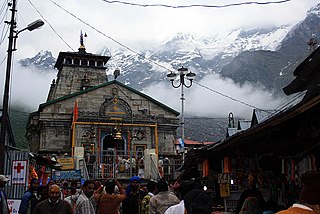
Garhwal is one of the two administrative divisions of the Indian state of Uttarakhand. Lying in the Himalayas, it is bounded on the north by Tibet, on the east by Kumaon, on the south by Uttar Pradesh state, and on the northwest by Himachal Pradesh state. It includes the districts of Chamoli, Dehradun, Haridwar, Pauri Garhwal, Rudraprayag, Tehri Garhwal, and Uttarkashi. The people of Garhwal are known as Garhwali and speak the Garhwali language. The administrative center for Garhwal division is the town of Pauri. The Divisional Commissioner is the administrative head of the Division, and is a senior Indian Administrative Service officer. As the administrative head of the division, the Commissioner is overall incharge of the 7 districts in the Garhwal region of Uttarakhand, and is aided in his duties by an additional commissioner and the district magistrates. Sushil Kumar is the divisional commissioner of the Garhwal Division since December 2021.
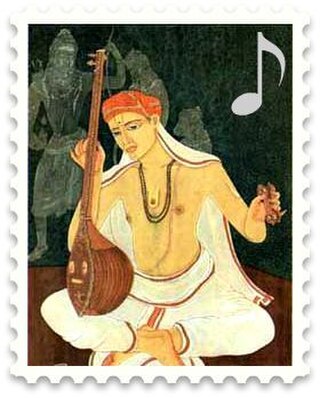
The folk music of Uttarakhand refers to the traditional and contemporary songs of Kumaon and Garhwal regions in the foothills of Himalayas. This music has it's root in nature and the hilly terrain of the region.
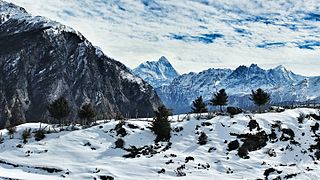
Uttarakhand, formerly known as Uttaranchal, is a state in northern India. The state is divided into two divisions, Garhwal and Kumaon, with a total of 13 districts. The winter capital and largest city of the state is Dehradun, which is also a railhead. On 5 March 2020, Bhararisain, a town in the Gairsain Tehsil of the Chamoli district, was declared as the summer capital of Uttarakhand. The High Court of the state is located in Nainital, but is to be moved to Haldwani in future.

Kumaoni is an Indo-Aryan language spoken by over two million people of the Kumaon region of the state of Uttarakhand in northern India and parts of Doti region in Western Nepal. As per 1961 survey there were 1,030,254 Kumaoni speakers in India. The number of speakers increased to 2.2 million in 2011.

Garhwali is an Indo-Aryan language of the Central Pahari subgroup. It is primarily spoken by over 2.5 million Garhwali people in the Garhwal region of the northern Indian state of Uttarakhand in the Indian Himalayas.
The bhankora is a type of brass instrument made of copper that is prominently used in the folk music of Uttarakhand in India, especially in the Garhwal region. The instrument is aerophonic and used in religious Garhwal folk dramas, most notably the Pandav Lila and Nanda Devi Raj Jat. The instrument is played only by upper class Garhwalis during the Naubat, Dhanyal, and Dev Jatra types of religious ritual performances. The bhankora is made of copper and is about 36 inches long and about 3 inches in diameter; it creates a sweet melodious sound and tone.

Indian folk music is diverse because of India's enormous cultural diversity. It is sung in various languages and dialects throughout the length and breadth of this vast nation and exported to different parts of the world owing to migration.
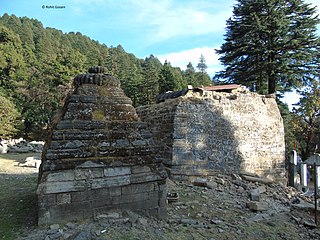
Pauri Garhwal is a district in the Indian state of Uttarakhand. Its headquarters is in the town of Pauri. It is sometimes referred to simply as Garhwal district, though it should not be confused with the larger Garhwal region of which it is only a part of.
The Bhotiya, also called Rongpa, are located in the trans-Himalayan region of India. Rongpa communities are some of the oldest and native of the upper belt of the Himalayas, close to the border of Tibet in Garhwal. It was once believed that the Rongpa community had been wiped out.

Jaunsar-Bawar is a hilly region in Garhwal division of Uttarakhand, northern India. It is located in the north-west of Dehradun district, along the border with the state of Himachal Pradesh.

Narendra Singh Negi, also referred as 'Garh Ratan' and 'Bob Dylan of the hills' is one of the most prominent folk singers, composer and a poet of the Garhwal and Uttarakhand who prominently sings in Garhwali language. Reportedly, he has sung more than 1000 songs. His unparalleled work in the field of folk music of Uttarakhand is an inspiration for all the upcoming singers of Uttarakhand.
Jagar is a Hindu shamanic form of Shamanism which is practiced in the hills of Uttarakhand, both in Garhwal and Kumaon. As a ritual, Jagar is a way in which gods and local deities are woken from their dormant stage and asked for favors or remedies. The ritual is connected to the idea of divine justice and is practiced to seek penance for a crime or to seek justice from the gods for some injustice. The word Jagar comes from the Sanskrit root, Jaga, meaning "to wake".

Garhwal Kingdom was an independent Himalayan kingdom in the current north-western Himalayan state of Uttarakhand, India, founded in 823 CE by Kanak Pal the progenitor of the Panwar dynasty that ruled over the kingdom uninterrupted until 1803 CE.
The mashak is a type of bagpipe found in Northern India, Uttarakhand, Sudurpaschim Province of Nepal and parts of Pakistan and Afghanistan. The pipe was associated with weddings and festive occasions. In India it is historically found in Kumaon and Garhwal in Uttarakhand, Rajasthan and Uttar Pradesh. This bagpipe uses single reeds, and can be played either as a drone or as a melody instrument.

Ramman is a religious festival and ritual theatre of the Garhwal region in India. It is a festival of the Garhwali People in the Saloor Dungra village of the Painkhanda Valley in the Chamoli district in Uttarakhand, India.
Chander Singh Rahi was a prominent folk singer, balladeer, musician, poet, storyteller, and cultural conservator from Uttarakhand, India.
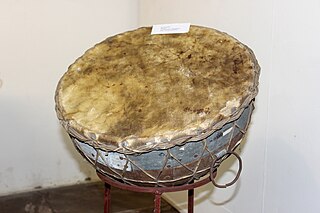
Damau is a single-headed drum instrument that is played extensively in the folk music of Uttarakhand in India. It is usually played along with the larger drum, the dhol, according to the ancient oral treatise of Dhol Sagar, which lists specific rhythm patterns for every occasion in life, including christening, wedding, religious festivals, folk drama and death rituals.
Pandav Lila or Pandav Nritya is a ritual re-enactment of stories from the Hindu epic Mahabharata, through singing, dancing and recitation, that is practised in the Garhwal region of Uttarakhand, India. Pandavas are the five protagonists in the epic and the village amateurs take on their roles and perform the lila outdoors, accompanied by the folk instruments dhol, damau and two long trumpets called bhankore. The performances, which can last anywhere from three days to a month in different villages, draw large crowds and are an important cultural highlight of the year. The ritualistic drama features actors who often spontaneously become "possessed" by the spirits of their characters and begin to dance.
Dhol damau or dhol damaun is the term used to collectively refer to two folk instruments of Uttarakhand and lower Himachal Pradesh, the dhol and damau, which are almost always played together on special occasions; though they may be played separately. The two instruments play a vital role in the lives of villagers, who often live in remote valleys of the region, and every important event is accompanied by their playing, which is considered auspicious. They are played according to the ancient oral treatise of Dhol Sagar that lists specific rhythmic patterns for every occasion, from celebrating birth and christening to religious ceremonies, folk dramas like Pandav Lila, and death rituals. Traditionally, they have been played by specific caste groups like auji, bajgi, das or dholi.












